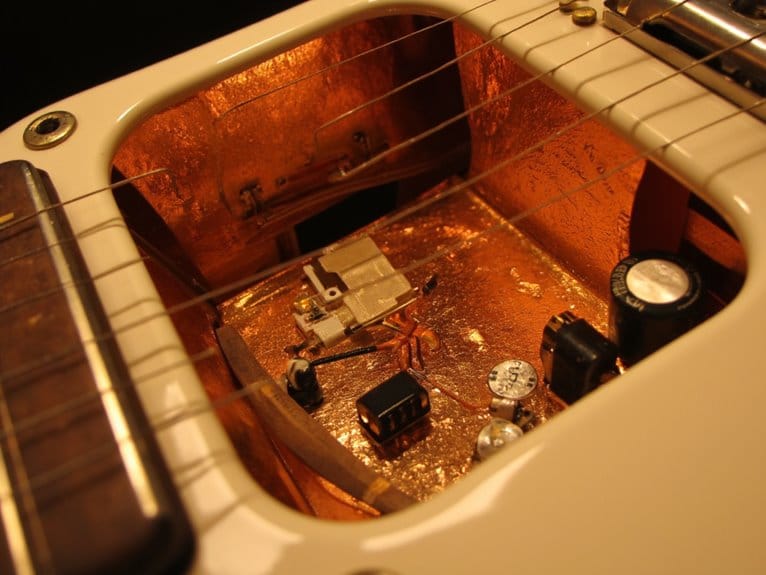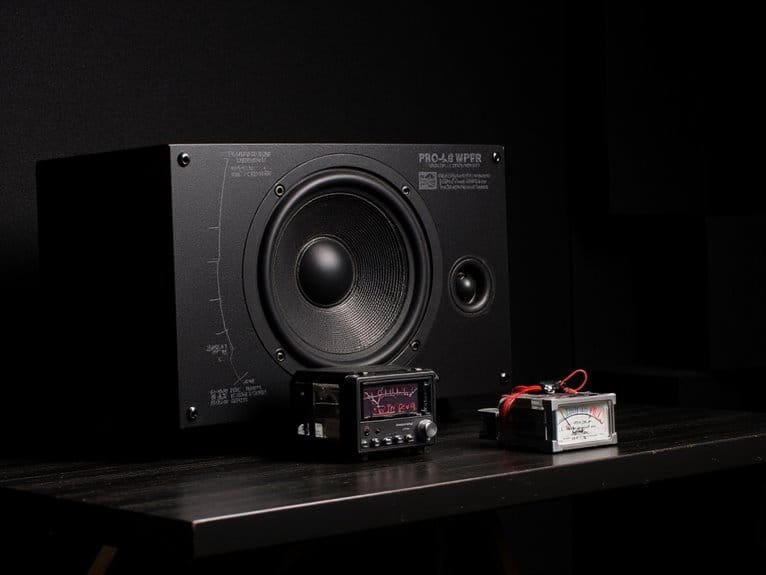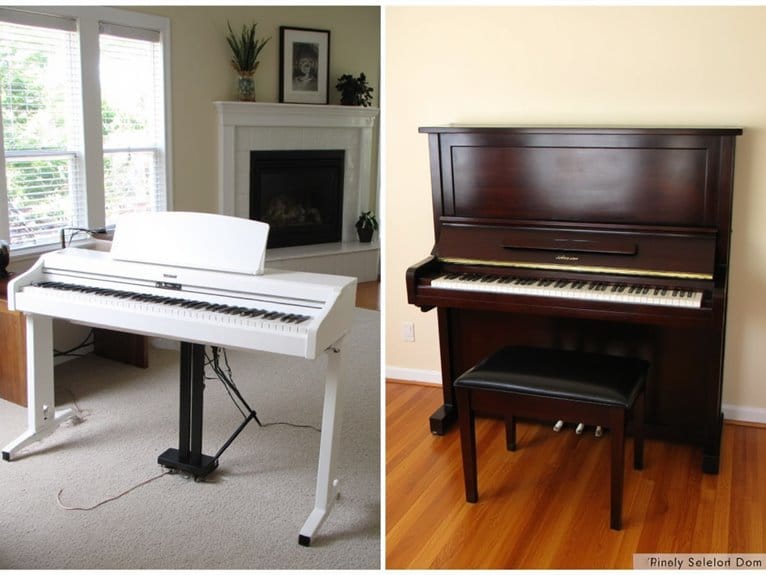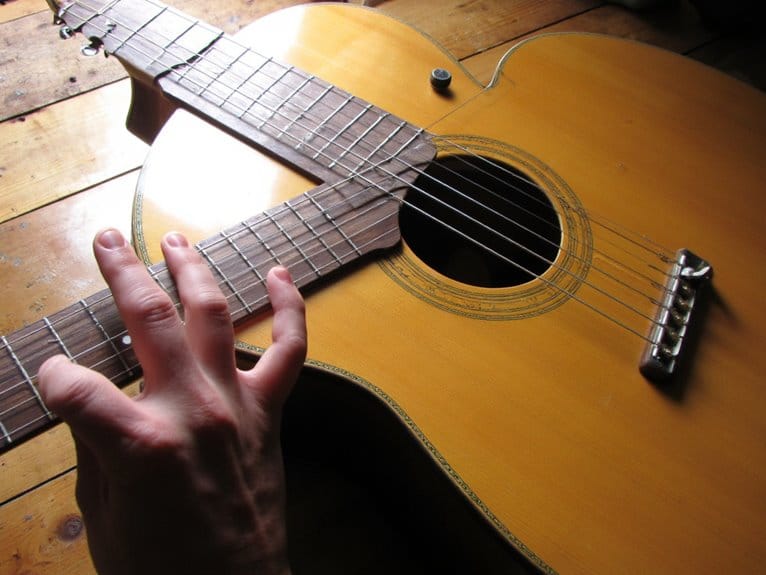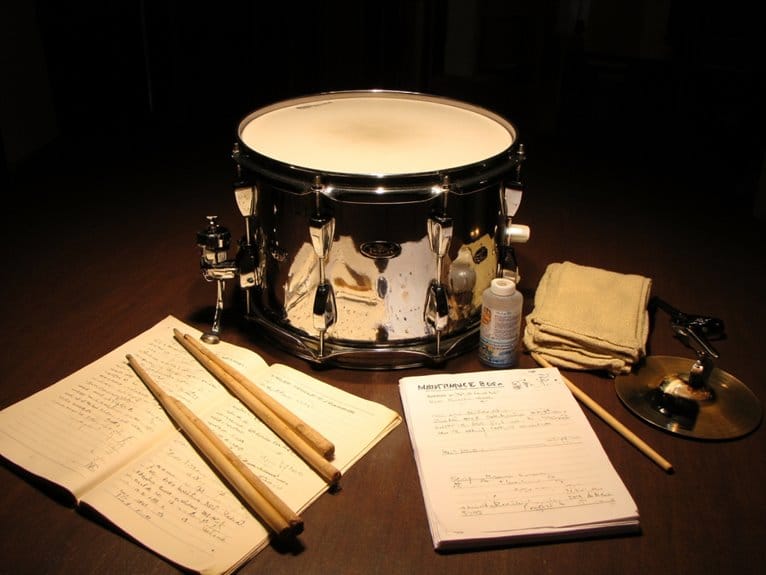Shielding Guitar Electronics: Reducing Noise
Guitar shielding transforms your instrument’s control and pickup cavities into a Faraday cage, blocking electromagnetic interference from fluorescent lights, digital devices, and that persistent 60 Hz hum from wall outlets. You’ll use copper foil tape or conductive paint to line these cavities, maintaining electrical continuity through overlapping connections while grounding everything properly. Though shielding primarily targets high-frequency EMI rather than low-frequency power line hum, it considerably reduces audible noise without affecting your tone. Understanding the nuances of different interference sources will help you achieve professional-quality results.
We are supported by our audience. When you purchase through links on our site, we may earn an affiliate commission, at no extra cost for you. Learn more.
Notable Insights
- Guitar shielding creates a Faraday cage that blocks electromagnetic interference from lights, digital devices, and electrical sources.
- Copper foil tape and conductive paint are primary shielding materials that must be grounded for effective noise reduction.
- Shielding primarily targets high-frequency EMI and radio frequency noise, not low-frequency 60 Hz power line hum.
- Complete cavity coverage with overlapping foil pieces and proper electrical continuity is essential for maximum effectiveness.
- Shielding works best when combined with humbucking pickups and proper grounding strategies for comprehensive noise management.
Understanding How Guitar Shielding Works
While many guitarists obsess over pickups and amplifiers, I’ve found that one of the most overlooked aspects of electric guitar performance is proper shielding, which creates an invisible barrier against the electromagnetic interference that can turn your pristine tone into a buzzing, crackling mess.
Guitar shielding fundamentally transforms your control and pickup cavities into a Faraday cage, intercepting radio frequency interference before it reaches your sensitive electronics.
When you line these cavities with conductive materials like copper foil or conductive paint, you’re creating a protective enclosure that blocks high-frequency EMI from sources like lighting dimmers and digital devices, preventing pickup interference that would otherwise manifest as audible noise in your amplifier.
Common Sources of Electromagnetic Interference
Everything around you in your home and practice space can potentially interfere with your guitar’s electronics, from the mundane 60 Hz hum radiating from wall outlets to the more complex electromagnetic signatures of modern digital devices.
Your fluorescent lights, LED fixtures, and switching power supplies create a cocktail of EMI sources that your pickups passionately collect like unwanted souvenirs. Computers, phone chargers, and even that old microwave in the kitchen contribute to this electromagnetic soup, while industrial equipment nearby adds its own broadband noise signature.
Different interference types require different approaches-electrostatic fields respond well to basic shielding, but those pesky radio frequencies from wireless devices demand more sophisticated mitigation strategies to keep your tone clean.
Shielding Materials and Installation Methods
Once you’ve identified the electromagnetic culprits plaguing your guitar’s signal, the real work begins with selecting and installing the right shielding materials to create an effective barrier against interference.
Copper foil tape offers excellent conductivity and coverage for flat surfaces like pickguards, though it requires careful application to avoid shorts. Conductive paint excels in complex cavity shapes where foil struggles, conforming easily to irregular surfaces while providing faster, neater application.
For successful installation, follow these essential steps:
- Line entire control cavities with shielding material to form a continuous conductive cage
- Overlap foil pieces precisely to maintain electrical continuity throughout the shielded area
- Connect all shielding to ground through solid ground points for effective noise diversion
Both materials complement each other perfectly, maximizing coverage while accommodating different surface geometries in your guitar’s electronics. Proper shielding implementation should achieve a noise floor comparable to professional audio equipment standards for optimal signal clarity. Professional recording setups typically employ ultra-low noise designs in their mixing consoles to maintain the cleanest possible signal path once your guitar’s electromagnetic interference has been properly addressed.
Maximizing Effectiveness and Managing Limitations
After you’ve installed your shielding materials with surgical precision, the real test comes in understanding what this protective barrier can and can’t accomplish for your guitar’s signal clarity.
Your shielding primarily tackles high-frequency electromagnetic interference and radio frequency noise, while low-frequency hum from power lines requires different grounding strategies to address effectively.
Shielding handles high-frequency interference and RF noise, but power line hum demands dedicated grounding solutions to eliminate effectively.
I’ve found that proper grounding integrity makes or breaks your entire noise management system-poor connections severely diminish any benefits you might expect.
Remember, shielding can’t eliminate all audible interference without impractically thick materials, so combining it with humbucking pickups creates a more exhaustive approach.
The key lies in managing expectations: shielding reduces specific noise types without altering your guitar’s true tone.
On a final note
You’ve now got the knowledge to tackle electromagnetic interference head-on, and honestly, it’s one of those modifications that’ll make you wonder why you waited so long. While shielding won’t solve every noise issue you’ll encounter, it’s remarkably effective against the most common culprits like fluorescent lights, computer monitors, and dimmer switches. The investment in copper tape and conductive paint pays dividends in cleaner recordings and more professional live performances.

